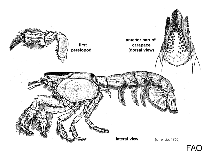Upogebia capensis (Krauss, 1843)
Cape mud shrimpИзображение на Google | No image available for this species;
drawing shows typical species in Upogebiidae.
Классификация / Names народные названия | синонимы | CoL | ITIS | WoRMS
Malacostraca | Decapoda | Upogebiidae
Environment: milieu / climate zone / пределы глубины / distribution range экология
. Subtropical; 26°S - 37°S, 16°E - 35°E (ссылка 4)
Distribution страны | регионы FAO | Ecosystems | места находок | интродукции
Southeast Atlantic and Western Indian Ocean: South Africa and Mozambique.
Length at first maturity / Size / Weight / Возраст
половая зрелость: Lm ? range ? - ? cmCommon length : 1.6 cm TL самец/пол неопределен; (ссылка 4)
Краткое описание морфология
Life cycle and mating behavior половая зрелость | размножение | нерест | Eggs | Fecundity | Larvae
Основная ссылка
ссылки | координатор | соавторы
Holthuis, L.B. 1991 FAO Species Catalogue. Vol. 13. Marine lobsters of the world. An annotated and illustrated catalogue of species of interest to fisheries known to date. FAO Fish. Synop. 125(13):292p. Rome: FAO. (ссылка 4)
Статус Красного Списка МСОП
(ссылка 130435: Version 2025-1)
Статус СИТЕС (ссылка 108899)
CMS (ссылка 116361)
Угроза для людей
Использование человеком
наживка: usually
| FishSource |
инструменты
дополнительная информация
Max. ages / sizes
Length-weight rel.
Length-length rel.
Размерный состав
Mass conversion
численность
ресурсы в Интернет
BHL | BOLD Systems | CISTI | DiscoverLife | FAO(Publication : search) | Fishipedia | GenBank (Геном, Нуклеотид) | GloBI | Gomexsi | Google Books | Google Scholar | Google | PubMed | Tree of Life | Wikipedia (Вперёд, поиск) | Zoological Record



